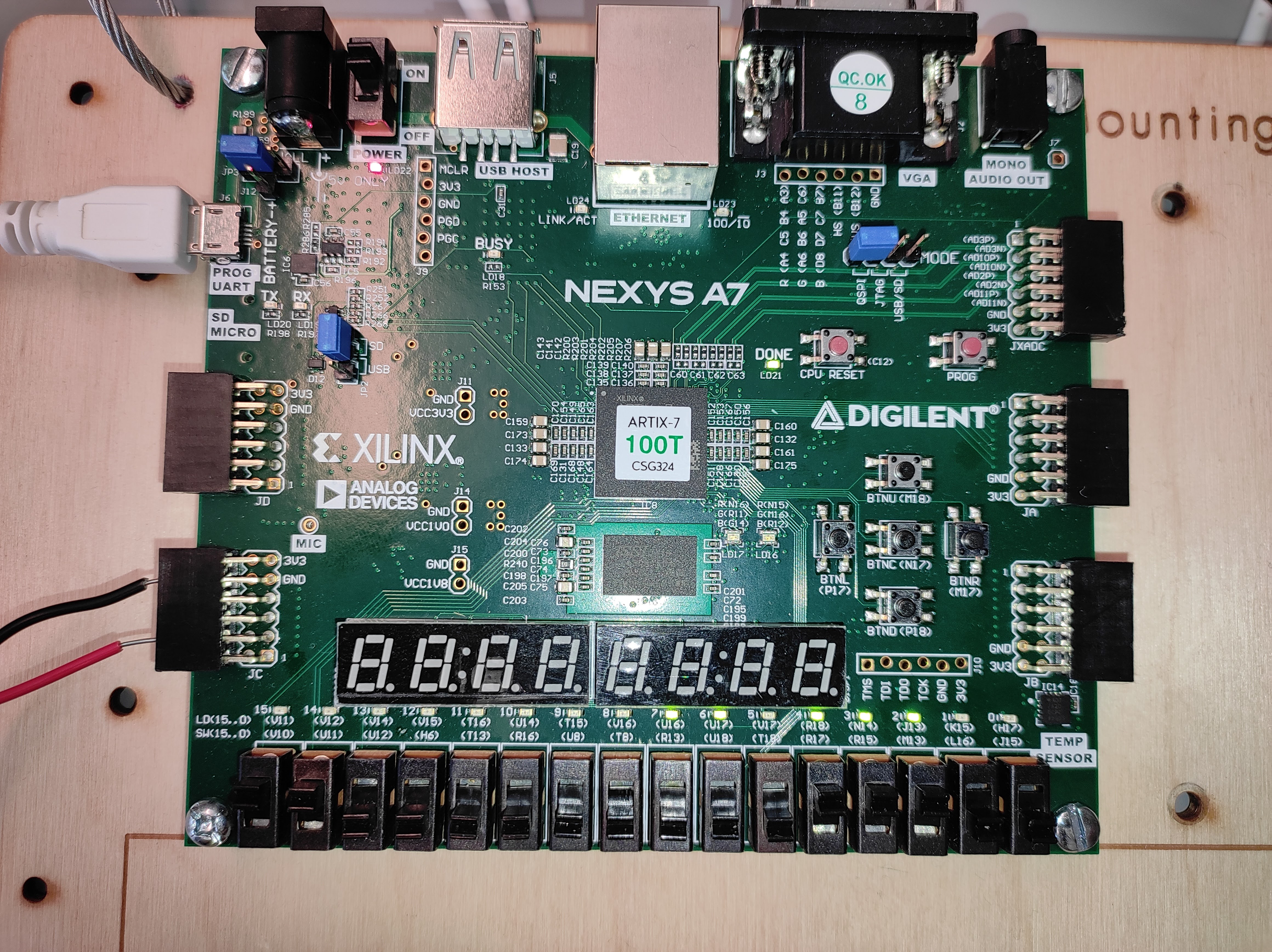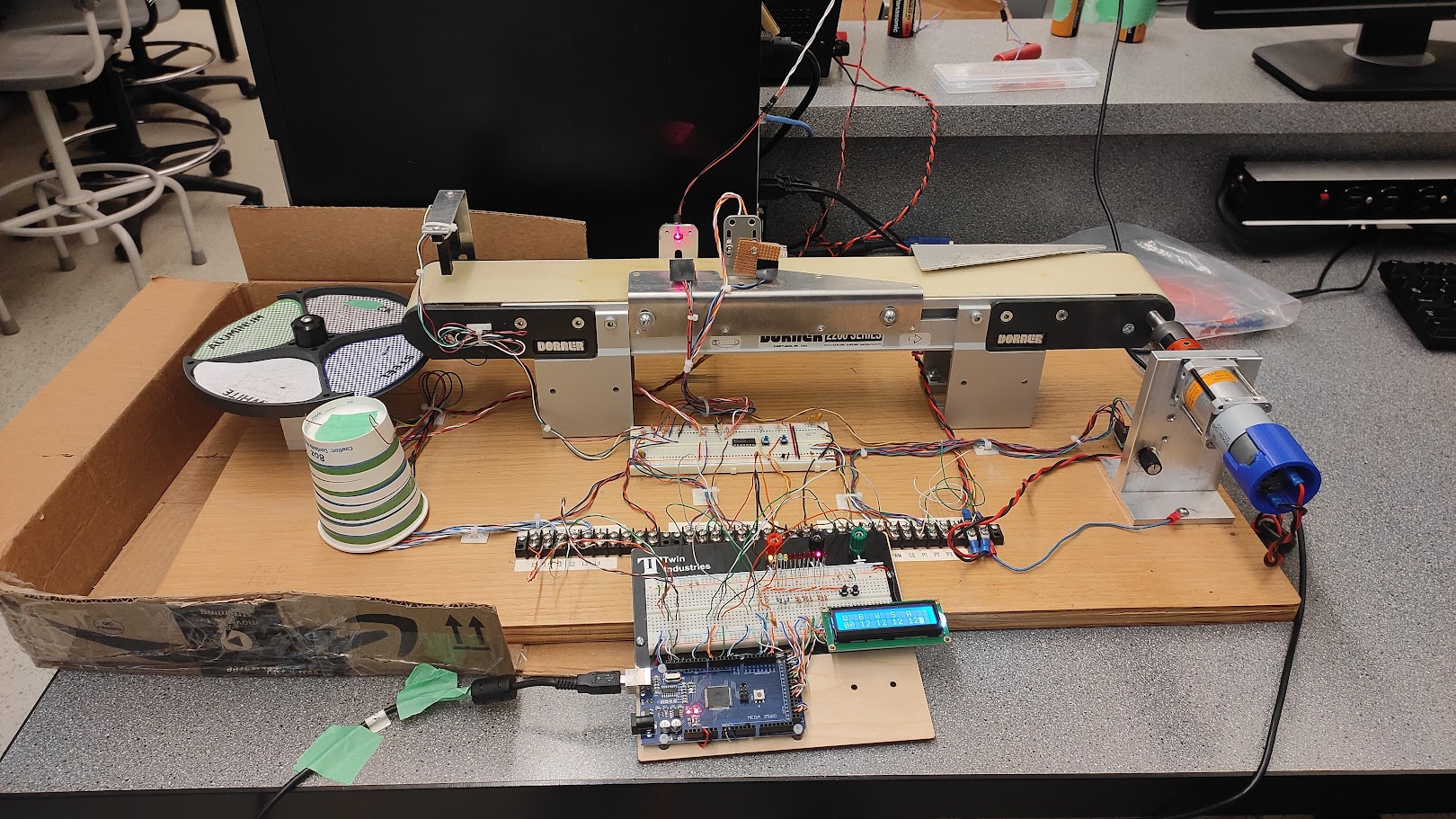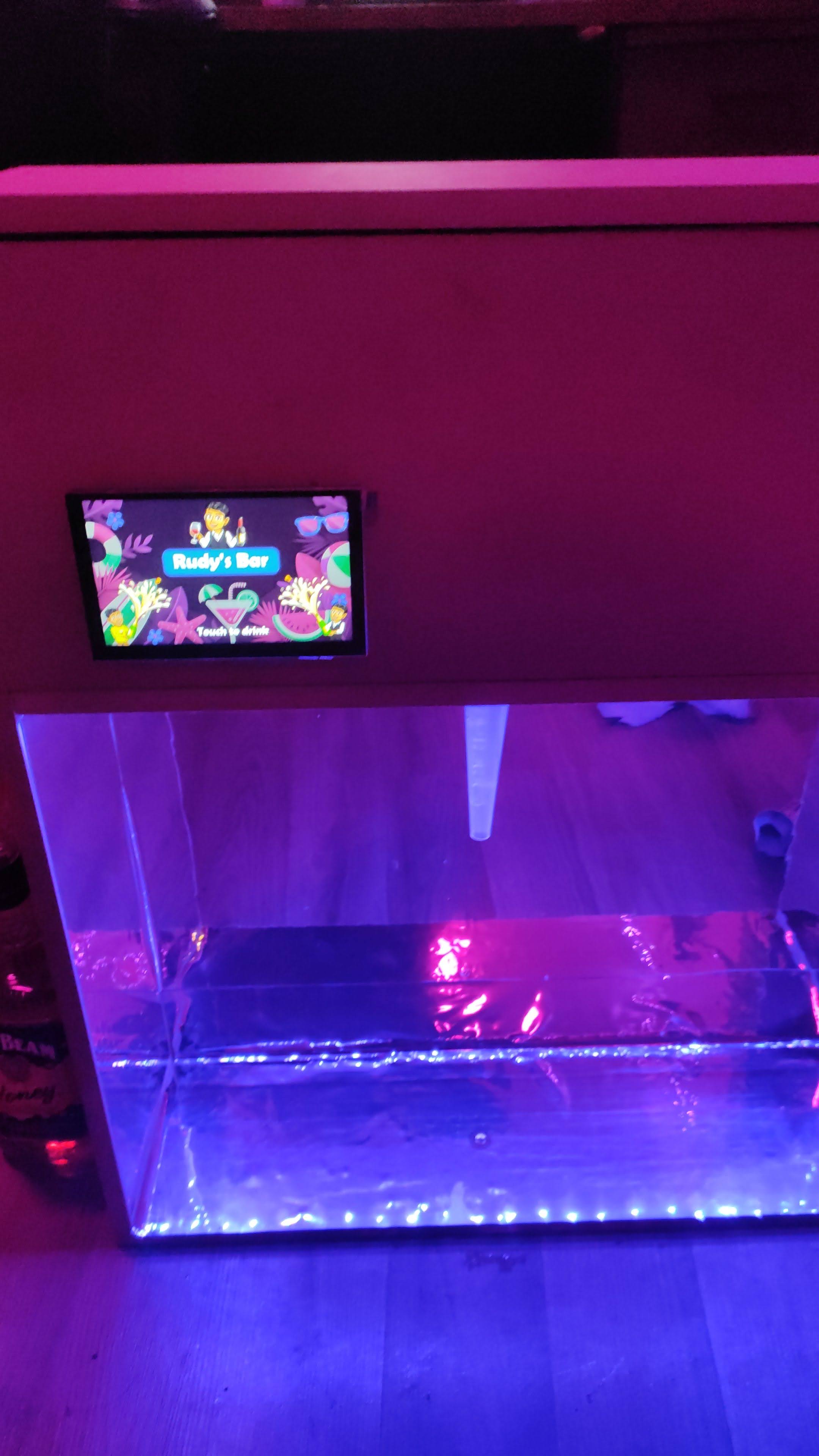Soft Core Processors and IP Blocks
Soft Core Processors and IP Blocks
Soft Core Processors and IP Blocks



Overview
As part of the ECE 441 course, my team and I explored the implementation of soft processors and IP integration on an FPGA using the Xilinx® Vivado® Design Suite. The objective was to create a functional soft processor system, integrate custom IP blocks, and utilize an integrated logic analyzer (ILA) for debugging. The project provided hands-on experience in designing and implementing complex systems on an FPGA.
Technical Approach
System Components:
FPGA Board: Nexys A7 FPGA board.
Processor: MicroBlaze™ microcontroller.
Communication: AXI_UART for virtual COM port communication.
GPIO: AXI_GPIO for interfacing with slide switches and LEDs.
Custom IP: Custom multiplier IP block.
Debugging Tool: Integrated Logic Analyzer (ILA).
Development Process:
MicroBlaze™ Microcontroller Instantiation:
Implemented a stand-alone MicroBlaze™ microcontroller using Vivado and SDK.
Demonstrated a "Hello World" program interfacing with slide switches and LEDs.
System with AXI_UART:
Integrated AXI_UART for virtual COM port communication.
Established bidirectional communication between the FPGA and a computer terminal.
Extended System with AXI_GPIO:
Added AXI_GPIO IP blocks to enable communication between slide switches, LEDs, and the COM port.
Modified C code to control the switches and LEDs.
Custom Multiplier IP Integration:
Created and integrated a custom multiplier IP block into the AXI bus system.
Implemented a 16x16 multiply operation in the custom IP.
Binary Counter and ILA Demo:
Implemented a binary counter and utilized the ILA for debugging.
Developed a VHDL module and C program to output a binary counter on GPIO pins.
Challenges and Solutions
FPGA Integration:
Challenge: Integrating multiple IP blocks and ensuring seamless communication.
Solution: Utilized the Vivado Design Suite for efficient IP integration and debugging.
Custom IP Development:
Challenge: Creating a custom IP block and ensuring its functionality within the AXI system.
Solution: Designed the custom multiplier IP, connected it through the AXI bus, and verified its operation using test benches.
Debugging:
Challenge: Debugging the system to ensure correct functionality.
Solution: Used the Integrated Logic Analyzer (ILA) to capture and analyze internal signals, facilitating efficient debugging.
Project Outcomes
Current Functionality:
Successfully instantiated a MicroBlaze™ microcontroller and demonstrated basic and extended functionalities with AXI_UART and AXI_GPIO.
Integrated a custom multiplier IP block and verified its operation within the FPGA system.
Implemented a binary counter and used the ILA for effective debugging and performance measurement.
Performance Metrics:
Demonstrated successful bidirectional communication and IP integration on the FPGA.
Measured the speed of the binary counter, observing a significant difference between hardware (50MHz) and software (1MHz) implementations.
Limitations:
The project focused on basic IP integration and custom IP creation. More complex systems and advanced IP blocks could be explored in future work.
Future Improvements
Advanced IP Blocks: Integrating more advanced IP blocks and exploring multicore implementations.
Optimized Designs: Refining the design for improved performance and resource utilization.
Automated Testing: Developing automated testing frameworks to validate IP functionality and system integration.
Conclusion
The Soft Core Processors and IP Blocks project provided valuable insights into FPGA-based system design, soft processor implementation, and IP integration. Through hands-on experience with the Vivado Design Suite, the project demonstrated the potential of FPGA technology for complex embedded systems and laid the groundwork for future developments in this field.
Overview
As part of the ECE 441 course, my team and I explored the implementation of soft processors and IP integration on an FPGA using the Xilinx® Vivado® Design Suite. The objective was to create a functional soft processor system, integrate custom IP blocks, and utilize an integrated logic analyzer (ILA) for debugging. The project provided hands-on experience in designing and implementing complex systems on an FPGA.
Technical Approach
System Components:
FPGA Board: Nexys A7 FPGA board.
Processor: MicroBlaze™ microcontroller.
Communication: AXI_UART for virtual COM port communication.
GPIO: AXI_GPIO for interfacing with slide switches and LEDs.
Custom IP: Custom multiplier IP block.
Debugging Tool: Integrated Logic Analyzer (ILA).
Development Process:
MicroBlaze™ Microcontroller Instantiation:
Implemented a stand-alone MicroBlaze™ microcontroller using Vivado and SDK.
Demonstrated a "Hello World" program interfacing with slide switches and LEDs.
System with AXI_UART:
Integrated AXI_UART for virtual COM port communication.
Established bidirectional communication between the FPGA and a computer terminal.
Extended System with AXI_GPIO:
Added AXI_GPIO IP blocks to enable communication between slide switches, LEDs, and the COM port.
Modified C code to control the switches and LEDs.
Custom Multiplier IP Integration:
Created and integrated a custom multiplier IP block into the AXI bus system.
Implemented a 16x16 multiply operation in the custom IP.
Binary Counter and ILA Demo:
Implemented a binary counter and utilized the ILA for debugging.
Developed a VHDL module and C program to output a binary counter on GPIO pins.
Challenges and Solutions
FPGA Integration:
Challenge: Integrating multiple IP blocks and ensuring seamless communication.
Solution: Utilized the Vivado Design Suite for efficient IP integration and debugging.
Custom IP Development:
Challenge: Creating a custom IP block and ensuring its functionality within the AXI system.
Solution: Designed the custom multiplier IP, connected it through the AXI bus, and verified its operation using test benches.
Debugging:
Challenge: Debugging the system to ensure correct functionality.
Solution: Used the Integrated Logic Analyzer (ILA) to capture and analyze internal signals, facilitating efficient debugging.
Project Outcomes
Current Functionality:
Successfully instantiated a MicroBlaze™ microcontroller and demonstrated basic and extended functionalities with AXI_UART and AXI_GPIO.
Integrated a custom multiplier IP block and verified its operation within the FPGA system.
Implemented a binary counter and used the ILA for effective debugging and performance measurement.
Performance Metrics:
Demonstrated successful bidirectional communication and IP integration on the FPGA.
Measured the speed of the binary counter, observing a significant difference between hardware (50MHz) and software (1MHz) implementations.
Limitations:
The project focused on basic IP integration and custom IP creation. More complex systems and advanced IP blocks could be explored in future work.
Future Improvements
Advanced IP Blocks: Integrating more advanced IP blocks and exploring multicore implementations.
Optimized Designs: Refining the design for improved performance and resource utilization.
Automated Testing: Developing automated testing frameworks to validate IP functionality and system integration.
Conclusion
The Soft Core Processors and IP Blocks project provided valuable insights into FPGA-based system design, soft processor implementation, and IP integration. Through hands-on experience with the Vivado Design Suite, the project demonstrated the potential of FPGA technology for complex embedded systems and laid the groundwork for future developments in this field.
Overview
As part of the ECE 441 course, my team and I explored the implementation of soft processors and IP integration on an FPGA using the Xilinx® Vivado® Design Suite. The objective was to create a functional soft processor system, integrate custom IP blocks, and utilize an integrated logic analyzer (ILA) for debugging. The project provided hands-on experience in designing and implementing complex systems on an FPGA.
Technical Approach
System Components:
FPGA Board: Nexys A7 FPGA board.
Processor: MicroBlaze™ microcontroller.
Communication: AXI_UART for virtual COM port communication.
GPIO: AXI_GPIO for interfacing with slide switches and LEDs.
Custom IP: Custom multiplier IP block.
Debugging Tool: Integrated Logic Analyzer (ILA).
Development Process:
MicroBlaze™ Microcontroller Instantiation:
Implemented a stand-alone MicroBlaze™ microcontroller using Vivado and SDK.
Demonstrated a "Hello World" program interfacing with slide switches and LEDs.
System with AXI_UART:
Integrated AXI_UART for virtual COM port communication.
Established bidirectional communication between the FPGA and a computer terminal.
Extended System with AXI_GPIO:
Added AXI_GPIO IP blocks to enable communication between slide switches, LEDs, and the COM port.
Modified C code to control the switches and LEDs.
Custom Multiplier IP Integration:
Created and integrated a custom multiplier IP block into the AXI bus system.
Implemented a 16x16 multiply operation in the custom IP.
Binary Counter and ILA Demo:
Implemented a binary counter and utilized the ILA for debugging.
Developed a VHDL module and C program to output a binary counter on GPIO pins.
Challenges and Solutions
FPGA Integration:
Challenge: Integrating multiple IP blocks and ensuring seamless communication.
Solution: Utilized the Vivado Design Suite for efficient IP integration and debugging.
Custom IP Development:
Challenge: Creating a custom IP block and ensuring its functionality within the AXI system.
Solution: Designed the custom multiplier IP, connected it through the AXI bus, and verified its operation using test benches.
Debugging:
Challenge: Debugging the system to ensure correct functionality.
Solution: Used the Integrated Logic Analyzer (ILA) to capture and analyze internal signals, facilitating efficient debugging.
Project Outcomes
Current Functionality:
Successfully instantiated a MicroBlaze™ microcontroller and demonstrated basic and extended functionalities with AXI_UART and AXI_GPIO.
Integrated a custom multiplier IP block and verified its operation within the FPGA system.
Implemented a binary counter and used the ILA for effective debugging and performance measurement.
Performance Metrics:
Demonstrated successful bidirectional communication and IP integration on the FPGA.
Measured the speed of the binary counter, observing a significant difference between hardware (50MHz) and software (1MHz) implementations.
Limitations:
The project focused on basic IP integration and custom IP creation. More complex systems and advanced IP blocks could be explored in future work.
Future Improvements
Advanced IP Blocks: Integrating more advanced IP blocks and exploring multicore implementations.
Optimized Designs: Refining the design for improved performance and resource utilization.
Automated Testing: Developing automated testing frameworks to validate IP functionality and system integration.
Conclusion
The Soft Core Processors and IP Blocks project provided valuable insights into FPGA-based system design, soft processor implementation, and IP integration. Through hands-on experience with the Vivado Design Suite, the project demonstrated the potential of FPGA technology for complex embedded systems and laid the groundwork for future developments in this field.

